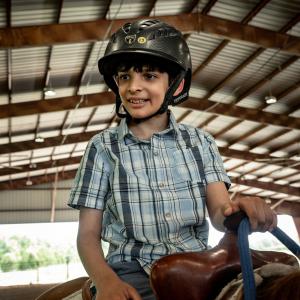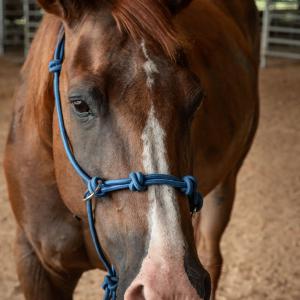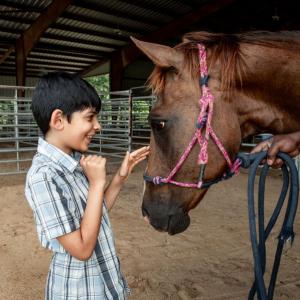Tranquil Trotting
Horseback riding helps meet special needs
Story by Bonnie Coblentz • Photos by Kevin Hudson
When 10-year-old Hasib of Starkville trots his horse during therapeutic riding, he experiences a lingering calmness that his mother attributes to the experience he shares with his horse.
Hasib, who has been diagnosed with autism, is participating in his third year of therapeutic riding activities offered by the Mississippi State University Extension Service. He rides Mudd, a 12-year-old quarter horse.
Hasib had ridden for 2 years at a therapeutic riding center in Virginia before his family moved to Starkville.
“Now, his sensory issues are better, his core muscles are much stronger, he follows directions, and he understands many more words and his ability to use them is much improved,” says Hasib’s mom, Mehreen Arbab. “His attention span has also increased.”
Lori Irvin, an MSU Extension associate who coordinates MSU Extension’s Equine-Assisted Services, explains there is something about riding and spending time with horses that promotes these successes.
“The most important thing for our riders is the bond they form with the horse,” Irvin emphasizes.
Riders in the program groom and spend time with their horses on the ground before they ride. With the help of volunteers in a professional setting designed for safety and achievement, riders are able to lead and ride their horses each week.
“Classes have a different theme each week aimed at meeting individual physical, cognitive, and social skills goals in a fun and enriching environment,” Irvin says.
These tasks are designed to meet specific goals for each rider.
“We talk before each semester, and Lori sets goals for Hasib for the week,” Mehreen explains. “Lori talks to me before every session and asks me if the goals are good and do we need to do more or less of something.
“If Hasib does not meet the goal for the week, we do it again next week,” she continues. “In the beginning, we worked on speech and strengthening core muscles. Now he is saying words, following directions, and talking to volunteers.”
MSU Extension accepts 12 riders each semester for this program, and participants ride once a week for 45 minutes to 1 hour.
“Volunteers are the heart of the program,” Irvin says. “Without volunteers, these riders would not be able to participate. And most of our volunteers report that they feel like they got more than they gave. Volunteering is rewarding and helps them forget their own stress for a moment.”
In addition to the therapeutic riding program that Hasib participates in for children with special needs, MSU Extension’s Equine-Assisted Services offers the MSU Veterans’ Horsemanship Program and equine- assisted learning for alcohol and drug recovery groups in residential treatment, many of whom have experienced domestic violence and human trafficking. There are also support services for veterans experiencing difficulty transitioning to civilian life.
Click here to give to Extension’s Equine-Assisted Services program.





